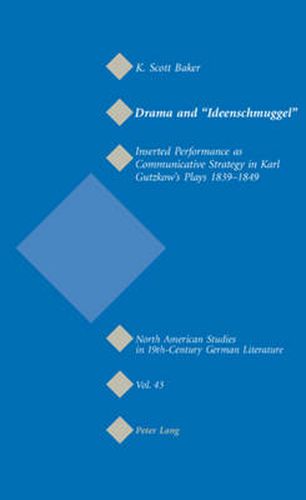Readings Newsletter
Become a Readings Member to make your shopping experience even easier.
Sign in or sign up for free!
You’re not far away from qualifying for FREE standard shipping within Australia
You’ve qualified for FREE standard shipping within Australia
The cart is loading…






This title is printed to order. This book may have been self-published. If so, we cannot guarantee the quality of the content. In the main most books will have gone through the editing process however some may not. We therefore suggest that you be aware of this before ordering this book. If in doubt check either the author or publisher’s details as we are unable to accept any returns unless they are faulty. Please contact us if you have any questions.
This monograph details Gutzkow’s recurring use of performance-within-the-play as a means of encouraging an active, political response by the audience. He incorporates an internal audience viewing a performance on stage in order to model an ideal of dramatic reception for the audiences of his own play. Gutzkow structures the narrative contextualization of these performances as reflections of specific issues in the German states of the Vormarz. Beginning with an overview of theoretical and literary texts from the 1830s, this study traces Gutzkow’s transferral of self-reflexive structures from his novels of this decade into his first staged play, Richard Savage (1839), and on through Das Urbild des Tartuffe (1844) and Uriel Acosta (1845). It concludes by portraying Der Koenigsleutnant (1849) as a transitional work that shows Gutzkow’s decision to return to the novel as a consequence of the failure of his plays to attain the reception he intended. By using the coherency of the communicated message instead of fealty to aesthetic norms as the evaluative criteria for discussing Gutzkow’s plays, the book exposes an innovative mode of specifically literary social criticism in these works that complements their traditional assessment as documentation of the cultural history of Liberalism in this period.
$9.00 standard shipping within Australia
FREE standard shipping within Australia for orders over $100.00
Express & International shipping calculated at checkout
This title is printed to order. This book may have been self-published. If so, we cannot guarantee the quality of the content. In the main most books will have gone through the editing process however some may not. We therefore suggest that you be aware of this before ordering this book. If in doubt check either the author or publisher’s details as we are unable to accept any returns unless they are faulty. Please contact us if you have any questions.
This monograph details Gutzkow’s recurring use of performance-within-the-play as a means of encouraging an active, political response by the audience. He incorporates an internal audience viewing a performance on stage in order to model an ideal of dramatic reception for the audiences of his own play. Gutzkow structures the narrative contextualization of these performances as reflections of specific issues in the German states of the Vormarz. Beginning with an overview of theoretical and literary texts from the 1830s, this study traces Gutzkow’s transferral of self-reflexive structures from his novels of this decade into his first staged play, Richard Savage (1839), and on through Das Urbild des Tartuffe (1844) and Uriel Acosta (1845). It concludes by portraying Der Koenigsleutnant (1849) as a transitional work that shows Gutzkow’s decision to return to the novel as a consequence of the failure of his plays to attain the reception he intended. By using the coherency of the communicated message instead of fealty to aesthetic norms as the evaluative criteria for discussing Gutzkow’s plays, the book exposes an innovative mode of specifically literary social criticism in these works that complements their traditional assessment as documentation of the cultural history of Liberalism in this period.